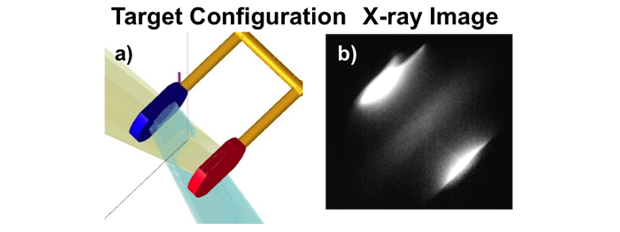James Ross (15-ERD-065)
Abstract
Magnetic fields abound in the universe, yet their generation and amplification mechanisms are still a mystery despite decades of research. Astrophysical plasma interactions are believed to play a key role in these processes. Weibel-mediated collisionless shocks are a possible mechanism for magnetic field generation. The Weibel instability occurs under high-velocity plasma flow conditions. The significance of this particular instability is its electromagnetic nature—it is predicted that an important fraction of the plasma flow's kinetic energy will be converted into magnetic energy. Not tested experimentally are the production conditions, the plasma parameters (such as ion and electron temperatures), and velocities at which the Weibel instability will dominate the interaction. With this project, we are exploring the fundamental microphysics of collisionless shock formation and magnetic-field amplification using laser-produced plasma streams that can be associated with the dynamics of astrophysical processes. Specifically, we are studying the generation of Weibel-mediated collisionless shocks and amplification of magnetic fields. Plasma interactions will be investigated using high-velocity plasma streams. Laser experiments are ideal to study these phenomena in a controlled fashion. We are using the OMEGA laser facilities at the Laboratory for Laser Energetics in New York and Livermore's National Ignition Facility, where very-high-velocity and hot plasmas can be created. Our study will produce a key understanding of the very basic fundamental plasma physics related to astrophysical magnetic fields.
If successful, we expect to generate a wealth of physics results related to magnetic field generation and amplification. The Weibel instability is conjectured to be a leading mechanism for creating magnetic fields in space, form collisionless shocks, and provide the required electromagnetic turbulence for cosmic-ray acceleration in these shocks. This project will enable us to observe and measure the creation and amplification of magnetic fields from collisionless shocks and the Biermann battery mechanism, in which a magnetic field is generated from a thermally generated electric field. Our approach consists of designing properly scaled experiments that can explain magneto-hydrodynamic processes using available magneto-hydrodynamic and particle-in-cell codes. We are pursuing experiments to observe fully formed collisionless shocks and utilizing existing Thomson scattering diagnostics to understand the plasma conditions. In addition, we are designing and constructing a suite of diagnostics that measures the strength of electric and magnetic fields, and performing high-power laser experiments to demonstrate the concept. While developing these experiments, we will add new measurement capabilities at the National Ignition Facility that can characterize magnetic field structure, electron spectrum, and plasma density.
Mission Relevance
Our laboratory astrophysics study will produce experimentally tested understanding of the basic plasma physics processes and dynamics underlying astrophysical magnetic field generation, in support of LLNL's core competency in high-energy-density science relevant to the scientific understanding of fusion-burning plasmas.
FY15 Accomplishments and Results
In FY15 we (1) completed three experiments at the National Ignition Facility to generate high Mach-number, counter-propagating plasma flows; (2) collected excellent data that showed a transition from the collisionless to the collisional regime—although very interesting, it appears that this transition took place before a collisionless shock had time to fully form; (3) used these experimental results in conjunction with two-dimensional magneto-hydrodynamic simulations to plan a series of collisionless shock experiments at the National Ignition Facility; and (4) completed OMEGA experiments to investigate the sensitivity of plasma flow parameters to incident laser conditions.
Publications and Presentations
- Huntington, C. M., et al.,"Observation of magnetic field generation via the Weibel instability in interpenetrating plasma flows." Nat. Phys. 11, 173 (2015). http://dx.doi.org/10.1038/NPHYS3178
- Park, H. S., et al., "Collisionless shock experiments with lasers and observation of Weibel instabilities." Phys. Plasma. 22, 056311 (2015). http://dx.doi.org/10.1063/1.4920959






